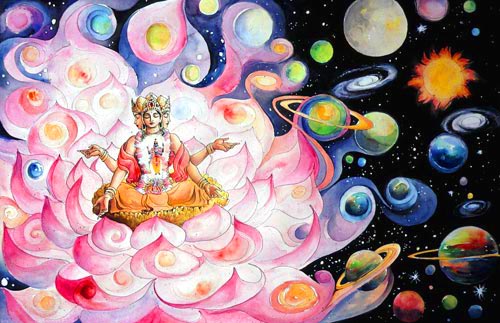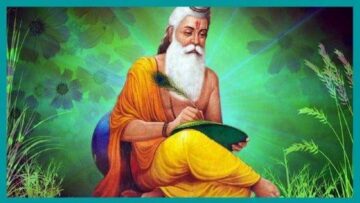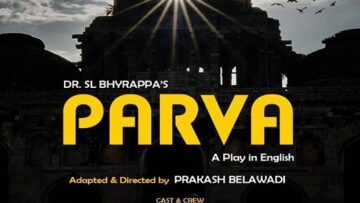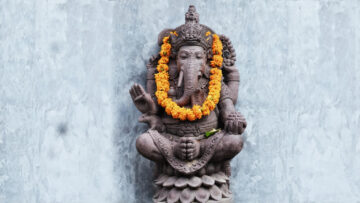The description of Srishti in the Puranas is well known. Among them, stories related to Srishti in the Bhagavata Purana are relatively more popular, both in the scholarly circles as well as in the larger communities of Bharatavarsha. The spiritual and the devotional dimensions of Srishti are well presented. It is also explored as an element of Hindu cosmology in an isolated sense of the word – without relation to other aspects of life. A lot of detail in the description of Srishti is often presented in the purview of Hinduism’s inclusivity of all aspects of life – in a metaphoric sense. Its relation to Hinduism’s inclusivity on the ground is also partially acknowledged.
However, Srishti as described in the Puranas, is far more holistic and relevant for the material world as well. The larger edifice of Srishti is ornamented with beautifully carved metaphors which are nothing but “Universal Principles”/Principle-Elements of Srishti”. They may be called as Srishti-Tatva or Srishti-Tatva Elements. This applies not only to Cosmology but for every act of human endeavour in our Universe. On the one hand, the Srishti Metaphors are an extraction of fundamental principles of creation through which the Universe that has created life can be abstracted. On the other hand, it is a framework, almost a tool-kit of principles, for human beings to guide their own endeavours and performances in the material world, to realize a sustainable life.
This paper presents a representative study of the principles of Srishti in the Bhagavata Purana. In particular, it presents a detailed analysis of the Skandha 3 where the Srishti is explained in all its splendour. The Paper converts these metaphors of “Universal Principles” that describe the essence of good Srishti and risks associated with Srishti-Kaarya. The paper presents a hypothesis of why these principles ought to be considered as Universal Principles. Finally, the paper converts these metaphors into a framework that could guide “creation” of all kinds by human endeavour with a view of creating a sustainable universe. The paper posits these Universal Principles as unique knowledge elements of the Bharateeya Parampara. This framework is presented by the way applying these principles to one of the contemporary situations and demonstrates a fruitful application of these principles.
In summary, the paper posits our Puranas as Knowledge Systems – uniquely Indian – that guide us both in the iha and the para worlds ie., the bhoutika and the adhyatmika worlds. Puranas are nothing but Knowledge Systems in the Bhoutika world containing Principles of Srishti, apart from principles for other domains, that could guide modern life.
The Splendour of Srishti Kaarya – Skandha 3 of Bhagavata Purana
Skandha-2 and Skandha-3 of Bhagavata Purana contain a structured and intense description of Srishti as described by Sage Maitreya to Vidura. Aspects of Sristhi appear in various other Skandhas of Bhagavata with some variations. However, the initial Skandhas provide the most fundamental perspective. Other Skandhas contain slightly altered views based on the respective contexts of those Skandhas. In addition, Skandha 2 provides a summarized version, whereas the Skandha 3 presents a detailed narration of Srishti. This paper anchors itself on Skandha 3.
Srishti Kaarya occurs in 4 Stages as described by the Skandha-3 of Bhagavata Purana
- The Creation of Mahat-Tatvas by Paramatma
- The Formation of the Virat-Purusha through the Mahat-Tatvas by Paramatma
- The Appearance of the Chaturmukha Brahma
- Creation of the Tangible Universe by Chaturmukha Brahma
The following sections describe each section in detail. The Paper assumes familiarity with certain terminology and presents them without an explanation.
Stage-1: The Creation of Mahat-Tatvas by Paramatma
In this section, let us walk through the creation of Mahat-Tatvas by Paramatma. The sequence is of consequence, although this paper does not exploit the sequence beyond a point. However, the focus of the paper is on the Mahat-Tatvas themselves, which we refer to as Principle-Elements of the Srishti Kaarya.
The Mahat-Tatva creation is as follows.
- Paramatma saw the universe as a Drashtaa and could not see anything. He perceived himself as incomplete. That was the Maya. It is from this Maya, that the Paramatma created the Universe.
- When the Maya felt disturbed, Paramatma sowed the seeds of the ‘Chidaabhaasa-roopa’ ie., the very reflection of Paramatma.
- Thus was formed the ‘Mahat-Tatva’. Paramatma saw the Mahat-Tatva. The grace of his sight transformed the Mahat-Tatva into a form to create the Universe.
- When the Mahat-Tatva was distorted Ahamkaara-Tatva was formed. It was of three forms – Satvika Ahamkara, Rajasa Ahamkara and Tamasa Ahamkara.
- Ahamkatara-Tatva led to Bhoota, Indriya and Manas through Kaarya (Adhibhoota), Kaarana (Adhyatma), Kartru (Adhidhaiva).
- Satvika Ahamkara resulted in Manas and all Adhishthana-Devatas of the Knowledges of various Subjects
- Rajasika Ahamkara gave raise to Gnanendriya and Karmendriya
- Tamasa Ahamkara gave raise to Bhoota and related Shabda. It is from them that the Akasha was formed.
- Paramatma then saw the Akasha. At that time, Kala, Maya and Chit – Amshas resulted in Sparsha-Tanmatra (Tanmatra: Subtle element of a Bhoota).
- Sparsha-Tanmatra, upon distortion (Vikara), became Vaayu.
- Vaayu, along with Akasha, after distortion became Form-Subtle (Roopa-Tanmatra)
- From Roopa-Tanmatra was formed Tejas.
- Tejas, Kaala, Maaya, Chit Elements along with Vaayu were graced by the sight of Paramatma that resulted in Jala-Tatva which is the Karya of Rasa-Tanmatra.
- Jala and Tejas were graced by the sight of Parabrahma along with the elements of Kaala, Maaya and Chit resulting in Prithvi with a special Gandha.
[It is important to note that it is evolving with Paramatma’s Chidabhaasa Roopa as the seed. This means that the Universe is a form of the very Paramatma himself. Secondly, it explains the nature of Leela as it describes that Paramatma perceived himself as being incomplete when he became the Drashtaa, although being incomplete, positing that Srishti Kaarya is a natural Karma for Paramatma. This has other implications but that is outside the scope of this Paper].
In this Stage, the Meta-Universe within which the physical Srishti must occur is itself evolving. The most important consideration from this Stage is that – the Srishti-Kaarya must begin by the formation of an Element-set for the Srishti. One must be able to imagine the nature of the eventual Srishti through its Elements. Such an Element-set must be complete in itself, in whatever ways, to create the desired Universe. This could be deemed as an important principle of Creation [PRI1].
In addition, this stage presents the most fundamental Element-Set that should be in place before a Universe is to be established. The ability of the Mahat-Tatvas to contain a primordial universe within itself is the other principle that emerges [PRI2]. This needs a deeper investigation and is the subject of another Paper.
Finally, the concept of Tanmatra is to be noted. The Boota-element has a subtle equivalent [PRI-2a].
Stage-2: Formation of the Virat-Purusha
As we can see, the Mahat-Tatvas created by Paramatma are separate and without interaction in the first stage. They are in a primordial form. They are potent for the creation of the Universe yet that is not the Universe in itself.
Devatas sought an intervention from Paramatma. [It is to be noted that the Adhisthana-Devatas have already been formed]. Pleased by the Devatas, Paramatma performed the following.
- Through his power of Kaala he entered these 21 Mahat-Tatvas – Ahamkara, Panchabhoota, Panchatanmatra, 11 Indriyas including the Manas.
- He invoked their Karma-s which were dormant.
- Thus, he brought all the Mahat-tatvas together through his Kriya-Shakti.
- Their coming together resulted in the Virat-Purusha. Everything was inside Him.
- Virat-Purusha was thus in the Brahmanda Kosha for a 1000 Divya Years. Virat-Purusha was thus ornamented with Jnana, Kriya, Atma-Shakti
- He divided himself in three different ways
- 1 Hrudaya
- 10 Pranas
- 3 Adhyatmika, Adhidaivika, Adhibhoutika
- Paramatma then woke the Virat-Purusha. At that time, all the Devatas found their place in the Virat-Purusha
- Face – Agni (Vak-indriya)
- Teeth – Varuna (Rasanendriya)
- Nostrils – Ashwini (Vasana-Indriya)
- Eyes – Surya (Netrendriya)
- Skin – Vaayu (Twag-Indriya/Sparsha)
- Ears – Dik (Shravana-Indriya)
- Skin – Aushadha
- Linga – Prajapati (Veera)
- Guda – Mitra
- Hands – Indra (Grahana-Tyaga)
- Feet – Lokeshwara Vishnu (Gati)
- Intelligence – Brihaspati (Bhiddhishakti)
- Hrudaya – Chandra (Manas – Sankalpa/Vikalpa)
- Ahamkara – Rudradeva (Kriya)
- Chitta – Mahat-Tatva (along with Chit-Shakti)
- From this awakened Virat Purusha the following were formed
- Svarga (Satva) from his Head
- Prithvi (Rajas) from his Legs
- Antariksha (Tama) from his Naabhi
Thus the Primordial form of the Mahat-Tavas being converted into a Virat Purusha was complete. Thus we now have the Universe in its most fundamental form, within which the actual life-dynamic could be established.
The following key principles emerge from this Stage.
- The Mahat-Tatvas become alive when Paramatma enters through Kaala. This means one has to define the fundamental elements of any Universe in the dimension of Time to be able to define a Universe [PRI-3].
- The Mahat-Tatvas have to be brought together in an inter-play to form the Virat Purusha, the Universe within which everything else resides. [PRI-4]. What is the nature of interaction/interplay between the Mahat-Tatvas? We shall explore that question subsequently.
Stage-3: The emergence of Chaturmukha Brahma
In the third stage of the Srishti, Srishtikarta Chaturmukha Brahma emerges. This recognizes the principle that creation of the dynamic requires an exclusive focus, with a single minded pursuit of creation [PRI-5]. The details are part of the same Skandha-3 but a subsequent Chapter, it is described as follows.
Shreemannaarayana is in a divine-sleep on Shesha-Talpa. Entire Universe was submerged in the Water. His Niyukta-Kaalashakti motivated him for the Srishti
- The Artha from his Mind joined the Rajoguna of the Kalashakti
- A Kamala was born from his Naabhi
- It brightened the entire Jala-raashi
- Bhagavan entered the Soon, Brahmadeva was born in the Kamala.
- The Adi-Brahma could not realize who he was and the rahasya of the Kamala-Tatva. He went in search of the roots of the Kamala, but could not find it.
- He then performed a penance for a 100 years, after which he saw the roots of the Kamala within his own Antah-karana.
- Brahma saw Kamala, Jala, Akasha, Vayu, Self from the Naabhi of Bhagavan
- The new Brahma-deva then drank Jala and Vayu.
- Divided the Kamala into 3 evident Lokas – Bhoo, Bhuvah, Suva and 4 subtle Lokas – Mahaha, Janah, Tapah, Satya.
This section underscores the three key principles
- Brahma was born from the Nabhi of Paramatma. This means that Srishti is subordinate to Sthiti [PRI-6]. This relationship between Srishti and Sthiti is very detailedly elaborated in my earlier paper on “Origins of Sustainability in the Vedic Philosophy – Author: Shivakumar GV”. The Parabrahman exclusively retains the Sthiti responsibility entrusting the Srishti and Laya to his creations. Hence, everything else that exists before him depends on Srishti.
- Artha from the mind joining the Rajo-guna represents the meeting of the meaning created in the mind with the dynamic force for creation [PRI-7]. A meaningful creation requires the tempering of the dynamic force with meaning. This also means a very clear understanding of the nature of Rajo-Guna, a clear articulation of the meaning or the purpose of the Creation and the Rajo-Guna’s ability to meet this larger purpose. If the dynamic force of Rajo-Guna is not enough, it must then be enhanced to meet the purpose. If it is more than the meaning, then it must be tempered.
- The identified Creator will have to perform the penance to realize the Supreme Eternal within himself before a meaningful Creation. This is an emphasis to ensure that the Creator has the knowledge of the whole [PRI-8].
- The Universe must be organized as multiple Lokas to enable a gradual transformation of the created-being to the ultimate state – Paramapada for spiritual purposes. In the material world, it must have a similar equivalent [PRI-9].
Stage-4: Chaturmukha Brahma creates the Universe
In this Stage, Chaturmukha Brahma creates the final stage of Universe that is most familiar to all of us in the Tradition. We operate within this physical and spiritual universe. Both are a real experience for the traditional Hindu. Chaturmukha Brahma performs following sequence of actions to create this final stage of the Universe.
- Creates Avidya, Moha (Asmita), Mahamoha (Raga), Tamisra (Dvesha), Andhatamisra (abhinivesha – pursuing something with a single minded devotion)
- Creates Sanat-kumara-adi Rishis so that they undertake the responsibility of Srishti of life-forms.
- Chaturmukha Brahma ordained them to perform Srishti.
- However, they were so deep in their devotion to the Parabrahman that they could not move themselves to perform Srishti.
- Creates Rudra
- Presented him the space of of Hrudaya, Indriya, Prana, Akasha, Vayu, Agni, Jala, Prithivi, Surya, Chandra, Tapas
- Ordained him to perform Srishti.
- However, the forms created Rudra leads to severe destruction
- Sends him to perform Tapas
- Creates the 10 Prajapatis
- Marichi, Atri, Angiras, Pulastya, Pulaha, Kratu, Bhrugu, Vasishtha, Daksha, Narada
- The Srishti begins with them
- Creates Dharma from the right side of his chest.
- Creates Adharma from the back
- Created Mrutyu from Adharma
- Creates Kama from Hrudaya, Krodha from the eye-brows, Lobha from the lower Lip
- Creates Saraswatee from the mouth, Samudra from the linga, Nir-Ruti from Guda
- Creates Kardama from his shadow.
- Creates Svayambhuva Manu and Shatarupa (Kaya)
It is from the Svayambhuva Manu and his son-in-law Kardama Prajapati that creation on earth started and rest is a different detail.
This final stage is very dramatic and potent with many Principles.
- Srishti not fulfilling itself through Sanat Kumara-adi Rishis and Rudra requires attention. Without the Sanat Kumar-adi Sages, there is no conscience keeping of Srishti. They are the purest forms of Srishti and they must serve as an inspiration but we cannot have them in large numbers. Hence, they are the first stage. Without Rudra, there is no destruction and hence no more future Srishti possible. Thus, a System ought to have two things
- Its purest forms should be visible [PRI-10].
- A person who makes way for the future by ending the present and the past is necessary [PRI-11].
- Dharma and Adharma both must exist before Srishti starts.
- The negative elements of arishadvarga must, in addition, exist for the Srishti dynamic to start. The Srishti dynamic must be an interplay between the positive and the negative [PRI-12].
A Brief Summary of the Overall Srishti
Let us now summarize the overall Srishti, before we proceed to the exploration of Srishti-Tatvas for application in the modern world – the 9 Forms of Srishti.
- Prakruta Srishti (Created by the Parabrahman)
- Mahat-Tatva
- Ahamkara
- Pancha Bhoota, Pancha Tanmatra
- Ekadasha Indriya
- Adhisthaatri-Devatas
- Avidya – Tamisra, Andha-Tamisra, Tama, Moha, Mahamoha
- Vaikruta Srishti (Created by the Chaturmukha Brahman)
- Sthavara – Vanaspati, Oushadha, Lata – Movement from the bottom to the Top
- Tiryak Yoni – Pashu, Pakshi without a sense of time, No Vichara Shakti, No Foresight
- Man – Ahara Sanchara from Top to Bottom, Rajoguna,
- Devasrishti – Satva Guna (Devata, Pitru, Asura, Gandharva, Apsara, Yaksha-Rakshasa, Siddha, Charana, Vidyadhara, Bhuta/Preta/Pishacha, Kinnara/Kimpurusha/Ashvamukha
- Sanatkumaradi Rushi
The Philosophy of the Four Staged of Srishti
On the one hand, it is easy to be lost in the beauty of poetic imagination that forms this fantastic description of Srishti. On the other hand, a modern mind may dismiss this as a merely fantastic description – an imagination that is neither scientific nor useful. However, there lies a set of fundamental principles that characterizes what is a balanced way of creating anything new that is in harmony with itself and the universe within which it operates.
Let us summarize the 12 Principles we have so far identified.
1. Any Creation of the actual universe must begin by the definite of Principle-Elements ie., Mahat-Tatvas [PRI-1].
-
- An articulation of Time
- Identification/Specification of Pancha Bhoota Elements
- Identification/Specification of their 11 Indriya Elements
- Identification/Specification of the Adhishthana Devatas
- Identification of Hrudaya, Prana, Adibhoutika, Adhidhaivika, Adhyamtika
This is a completely different way of conceptualizing a system. This makes any system a fractal of the larger universe and hence more likely to be in harmony with the larger universe.
2. The Mahat-Tatvas must be complete in their definition to construct the desired universe [PRI-2].
3. Everything must be defined at two levels. The Seeming and the Subtle [Tanmatra] – especially the elements that are used to construct the System [PRI-2a].
4. The Mahat-Tatvas should be activated through Kaala [PRI-3].
5. The Mahat-Tatvas should be brought together to form the Virat Purusha which is the Meta-Universe [PRI-4].
6. Every System ought to have a Srishti-Karta who performs the Cycle of Creation with a single minded pursuit [PRI-5].
7. Chaturmukha Brahma is born from the Naabhi of Paramatma. He needs rigorous Tapas to realize Paramatma within his Antahkarana. Hence, Srishti is subordinated to Sthiti [PRI-6].
8. Artha must join the Rajo-Guna of Kaalashakti for the Chaturmukha Brahma to be realized. The Purpose of Srishti must meet the dynamic force of time for true Srishti to materialize. Hence, defining the Purpose and identifying/characterizing the dynamic force of the times and balancing the two for proportionately very essential. Leaders emerge from within this exercise [PRI-7].
9. The identified creator will still need a penance to align/identify and realize the invisible Meta-Universe before the creation of different forms in the Universe [PRI-8].
10. The Creator must conceptualize the Universe as Multiple-Lokas so that there is a space for dynamic movement of the created forms from One Loka to another. The organization of these Lokas will decide the health of the Universe [PRI-9].
11. Identify the Sanatkumar-adi conscience keepers, the purest forms of creation [PRI-10].
12. Identify the Rudra who ensures that the old forms give way to new forms [PRI-11].
13. Identity the Dharma – that which sustains everything else, Identity the Adharma that which results in everything falling apart and identify all the Arishad-varga-adi elements with which a clear interplay is constantly necessary [PRI-12].
Only within such a system that the Prajapati-s and the Manu-s can perform this ground-level Srishti-Kaarya effectively.
This paper proposes that these are universal principles for any system design. Its inspiration comes from the Sristhti-Sthiti-Laya principle where everything at all times should be in balance with Sthiti. The Creation of Mahatatvas by Parabrahman is emphasizing all the elements that must be in place for any human creation too to be in balance with the eternal principle of Sthiti. These principles apply both while performing creation within an existing universe or when operating within an existing universe. Within an existing universe, these Tatvas must be identified ; Srishti must be in harmony with those Tatvas.
Elaboration of some Mahat-Tatvas in the Srishti Karya
This section further elaborates certain Mahat-Tatvas in terms of the role they play in Srishti. It is represented in terms of their relevance to a Modern System.
- The Kaala (Time) Tatva: Any Creation should have a sense of Time. This means the conditions upon which it is created and destroyed must be a critical factor in the very design. Anything without sufficient indulgence in these leads to an imperfect system and goes against Sthiti [M-PRI-1].
- The Bhoota Tatva: It is necessary to identify and articulate the corresponding Bhoota elements in the System [M-PRI-2].
- Agni represents the Creative Force within the System.
- Water represents the Tempering Force/Sustaining/Flow Maintenance force
- Vayu represents the Perception Force
- Prithvi represents the containing capacity
- Akasha represents the larger space for the dynamic.
A correspondence ought to be established between the Bhoota-Tatvas and the eventual Universe being created. The Bhoota-s ought to have the strength to contain and hold the Universe being created.
3. The Indriya Tatva: The System must call out the 11 Indriyas and spell out their behaviour [M-PRI-3].
-
- The 5 Jnana Indriya – Chakshu, Shrotra, Ghrana, Rasanaam Twak
- The 5 Karma Indriya – Vaak, Paani, Paada, Paayu, Upastha
- The Ubhaya Indriya – Manas
While the Bhoota Tatva represents the Universe of the System, the Indriya Tatva represents the dynamic of the System. It is necessary to imagine a System through its ability to see, listen, smell, taste and touch everything that comes its way. It is necessary to imagine a System through the kind of conversations it creates within its elements, what it holds and what it leaves, what is the movement that it offers within, how does it enable regeneration and how efficiently it enables elimination of the waste and make them part of the Bhoota.
4. The Adhishthana Devatas: The System must provide people or mechanisms with characteristics that represent the following Adhishthana-Devatas [M-PRI-4].
-
- Agni (Vak-indriya), Varuna (Rasanendriya), Ashwini (Vasana-Indriya), Surya (Netrendriya), Vaayu (Twag-Indriya/Sparsha), Dik (Shravana-Indriya), Aushadha, Linga – Prajapati (Veera), Mitra, Indra (Grahana-Tyaga), Lokeshwara Vishnu (Gati), Brihaspati (Bhiddhishakti), Chandra (Manas – Sankalpa/Vikalpa), Rudradeva (Kriya)
The Adhishthana Devatas emphasize the necessity of expertise within the system to guard the Indriya Tatvas.
5. The Avarana: The System must provide for various possibilities that make people within operate without a complete view of the System. System must be defined for those partial views and constantly enable people to move from partial views to complete views.
-
- The Avidya (The Sub Universes that create partial view)
- The Moha (Allowed Identities and ways to overcome those identities)
- The Mahamoha (Attachment possibilities)
- The Tamishra (Repulsion possibilities)
- The Andha Tamishra (Instruments of dangerous perseverance within the System) [M-PRI-5]
Once these elements are defined, the creator of the System has to imagine a meaningful interaction between all of these which forms the invocation of the Virat Purusha with all the Maha-Tatvas being activated and brought together to interact with each other. The balance of the system is upon the creator to demonstrate.
Applying the Srishti Principle-Elements to Modern Systems
The above sections present an alternate way of thinking about a System. We have extracted what could be deemed as Principle-Elements that can be used to construct any System. However, its efficacy can only be demonstrated by redesigning a modern system in this image and then demonstrating that the resulting system is superior. That is a Himalayan task in itself, it requires substantial resources for a redesign to be performed and efficacy demonstrated.
However, we can make a beginning by re-imagining existing systems. There are two ways in which we can re-imagine.
- Complete redesign of an existing System through the Principle-Elements of the Srishti Kaarya
- Evaluation of an existing System through the Principle-Elements of the Srishti-Kaarya
The Srishti-Kaarya of Bhatavata Purana provides us with a framework/tool-kit to view a given System as a living entity and life-sustaining dynamic elements. This view is evidently universal and relevant for all times.
Let us consider the ‘Modern State’ as a System and use the Principle-Elements framework to evaluate the same.
Let us reimagine a State in this way.
- What is the Force of Creation (Agni)
- The Legislature
- What the Moving Force (Vaayu)
- The People
- What is the Containing Element (Prithvi)
- The Community
- What is the Tempering Element (Apa)
- The Judiciary
- What are the Sthiti Elements of the State
- The Constitution
- The Community
- What are the Laya Elements of the State
- The Election Commission
- What are the Indriyas that the State provides the people in order to See, Listen, Indirectly Perceive, Directly Perceive and Feel the State
- Has the State explicitly created Instruments for the same
- What is the Manas of the State
- Is the Legislature performing this Role
- If any other organ of the State is performing the Role, how is it impacting everything other organ of the State
- What does it mean to enter the Mahat-Tatvas through Time? How are these elements visualized against time? [This is an angle that is completely absent in the modern Systems. Every element has a time factor, Modern systems have Time factored in only for the larger system but not for its elements].
- Who are the Adhishthana-Devatas? Are the ministers of the Cabinet to perform this role? Or do we need an State-Element outside of it? Or do the Secretaries of various departments play that role? Or is it a separate Think-Thank? Or is it the Prime Minister’s Office?
- What are the Sub-Universes of the State where the State is not completely visible? Are the Communities operating as closed environments blocking the visibility of the State completely? How do we make individuals in a Community see the State very clearly? What is the Vidya that is required to achieve the same?
- What are the Identities that the State allows? Is the Community, region, city identity healthy? If it is not healthy, how is the State enabling a release from those Identities which cause Moha? What are the instruments and institutions that are created to resolve this?
- What are the other elements within these Sub-Universes that blur the identification of an individual with the State?
- What are the elements within the State that can create a repulsion for an individual away from the State? What are the instruments to avoid them?
- What are the instruments of dangerous perseverance within the state that can harm the functioning of the State and the individual?
- What is the Kriya-Shakti?
- Does the state have a Hrudaya? What is the Hrudaya? What is the Prana?
- What is the Svarga – the elevating force? What is Prithvi – the containing element? What is the Antariksha? Which are the other Lokas? How is each Loka contained within the other? How are we enabling a Citizen participation in each Loka (Of the State, not merely of Election)
Thus, the Srishti Tatvas of the Bhagavata Purana could be effectively utilized as an upper layer to existing State architecture, that are largely derived from the Western world. This approach could then be used to temper the state and gradually move it to a design that is fully inspired by the Srishti Tatvas.
The Next Steps
As a framework to evaluate an existing System, the Srishti-Tatvas serve as a very meaningful framework. Their usefulness is quite evident. These are often questions asked by external agencies, often, in an assorted manner. The Srishti-Tatvas organize them into beautiful principles and a framework.
However, there is more to be done. The efficacy of the Srishti-Tatvas, as principles and as design, will have to be established independently. The following important questions are yet to be answered.
- Are these Tatvas sufficient to describe a System independently and completely?
- The interplay between these Tatvas arent described by the Bhagavata Purana. This leaves us with two options.
- Leave the Elements as independent autonomous entities but design them as entities very strongly.
- Define the interplay between these Elements very strongly.
2a results in the Bharateeya approach to life – the Sutra way and 2b results in the Model approach to life – the Western Way.
These aspects ought to be further elaborated and constitutes the subject of another paper.
Conclusion
The Srishti Kaarya explained in the Bhagavata Purana provides us with Elements and Framework that has the potential to be an independent System-Design framework. At the very least the framework can be used as a way of evaluating an existing framework. Further, there are two ways in which it can be converted into a full-fledged System Design framework. One approach takes us in the traditional Bharateeya direction of Sutras. Another approach takes us in the direction of western Models. Either way, it is necessary to extend it further and then reimagine Systems in their light.
Watch video presentation of paper here:
Image Credit: sanskriti magazine
Disclaimer: The opinions expressed in this article belong to the author. Indic Today is neither responsible nor liable for the accuracy, completeness, suitability, or validity of any information in the article.











